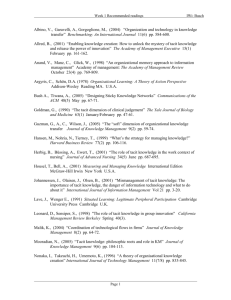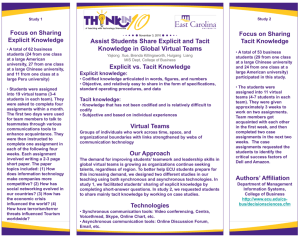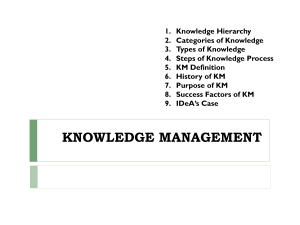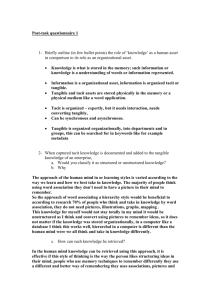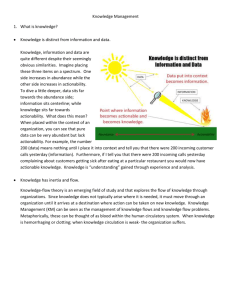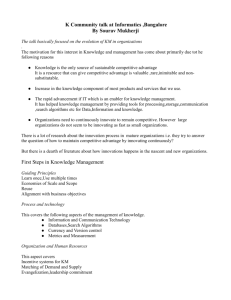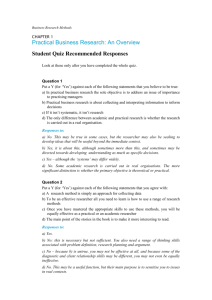Chapter10-Global innovation
advertisement
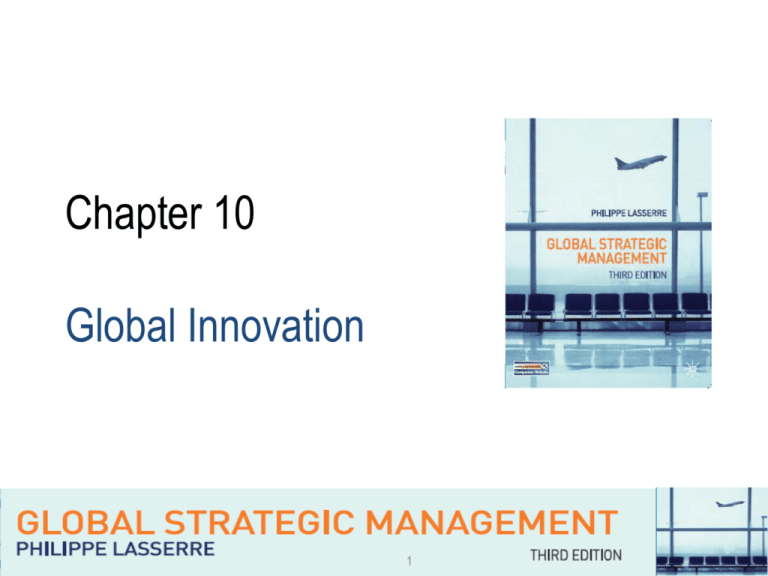
Chapter 10 Global Innovation 1 Global innovation Forces at work: Increasing costs Shortening product life cycles Increasing importance of TIME-to-MARKET for competitive advantages Increasing importance of customers participation in technology development Increasing importance of networking, partnerships and alliances in technology development Increasing importance of multi-disciplinary integrative technologies Emergence of new centres of technological excellence: India, China 2 The world of R and D Source: Barry Jarulesky and Kevin Dehoff, Beyond Borders: The Global Innovation 1000, Strategy and Business, Booz and Co, 2008 3 3 R&D capabilities Country R and D Expenditures Number of Researchers (% of GDP) 2000 2005/2009 2000 2005/2009 India 0.77% 0.80%** 112971 149892* China 0.90% 1.44%*** 692698 1411000*** Japan 3.04% 3.44%*** 648411 712062*** USA 2.74% 2.71%*** 1264372 1392000** European Union 1.80% 1.85%*** 1102045 1459151*** High Technology Exports ( million US$) 2000 2009 1569 10143 40837 348295 127376 99210 196698 141519 385186 515167 Source: World Bank World Development Indicators (2011).For the period 2007/2009 data with * are for 2005, ** for 2006, ***for 2007 4 Patents Applications 2000 8503 51906 419543 295895 165513 2009 28940** 314513 348592 456154 130278 Increasing Importance of Emerging World Source: Unctad, 2005 5 5 Globalisation of R and D and Performances 6 6 Source: Deloitte: Innovation in Emerging Markets 7 7 8 8 Source: Deloitte: Innovation in Emerging Markets Managing global innovation • Knowledge creation • Knowledge sharing / transfer 9 Knowlege Creation Internationalisation of Research And Development in multinational corporations Central Lab Central Lab Central Lab 10 Central Lab Knowledge creation Some of The Well Established Traditional R & D Management Principles • “Critical Mass Requirements”: 50 to 100 minimum size for a multi-disciplinary laboratory • Linkages with sources of scientific knowledge: Proximity to universities • Face to face communications: Personal contacts • Pooled R & D more efficient than sequential • Growing need for closer interaction with customers 11 Knowlege Creation International R & D Networks ADVANTAGES DISADVANTAGES • Close to markets • Loss of critical mass • Close to production • Close to raw materials • Close to universities • Small size • Flexibility • Integrating acquisitions • Difficult to communicate • Risk of duplications • Difficult to integrate 12 Knowlege Creation A Typology of Research Units Research laboratories In charge of long projects, dealing with new technologies or scientific discoveries that are not necessarily related to a particular product. These laboratories are global by nature, and most often, but not always, are located near the corporate centre. Development laboratories In charge of projects which has the objective to lead to a product or process innovation. Supporting/adaptive units Provide product or process adaptation according to local contexts. Scanning units Monitor technological development and contribute to the knowledge platform of the company. 13 Knowledge dispersion profile for ST in Hard Disk Drive electronics Joint design center with Seagate: Scotts Valley, CA Engineering and design skills in digital servo controllers: (JV) SSD - Dublin, Ir. Engineering and design skills in fast microprocessors: Bristol, U.K. Process technology R&D in BICMOS (mixed) and CMOS (digital); Manufacturing (Front End): Grenoble, France Microprocessor development: (JV) Siemens, Germany Lead Customers R&D and Engineering: Seagate, Western Digital (California,Colorado, ...) Competence on R/W technology: (JV) EXAR, CA Engineering and Design Capability / Close understanding of customer application / Design Center: S. Jose CA Design of ‘packaging’, testing and final assembly (Back End) capability: Malaysia, Singapore Customers’ manufacturing: Singapore, and other Far East loc Source: Doz, Santos, Williamson 14 Process technology R&D in Bipolar and BCD; Design competence on analog and mixed chips: Castelletto and Agrate, (near Milano), Italy Coordination and strategic capability: Geneva, Switzerland Knowlege Creation Knowledge Complexity is a combination of Tacitness and Embeddedness (Context-Dependant) Existential Knowledge Complex “Feel and Live” “Study and Live” Endemic Knowledge Experiential Knowledge “Experience & Practice” Simple Source: Santos “See & Study” Explicit Knowledge “Creep into the Mind” (Tacit and Context Dependent) • Learning by doing and discovering • • • JIT and TQC in Japan, Cultural assumptions (Fashion, Music, Arts) Joint teams approach “See through the Eyes” (Codified and Context Dependent) • Learning by seeing • Long term secondments • Apprenticeship “Jump into the Shoes”( Tacit and General) • Learning by studying • • • Practices and skills Cases studies Short term secondments “Take a Picture” ( Codified and General) • Learning by reading • • Technical blueprints Patents 15 Source J. Santos Knowlege Creation Tapping on the Global Diversity of Competencies C&D High Diversity of Knowledge Sources Low D&D Co-Location and Diversity Dispersion and Diversity The tower of Babel Knowledge creation and sharing in one place with the participation of managers detached from dispersed business units. The secondment practice. The virtual team Knowledge creation, sharing in several placeswith the ability for the company to create the conditions for effective sharing of tacit knowledge. C&C D&C Dispersion and Congruent The Diaspora Team Virtual co-location Knowledge creation, sharing in several places but with expatriate managers coming from the same “intellectual” mold. Classic role of expatriate managers Co-Location and Congruent “Centre of Excellences” Classic Co-location Teams. Knowledge creation, sharing in one place and possibly transferred later. Same Location 16 Distant Source: J Santos Knowledge Transfer HIGH Move information about the technology to where the market knowledge is Move information by rotating people and by temporary co-location COMPLEXITY of MARKET KNOWLEDGE Move information about the market to where the technological knowledge is Exchange information ( Digital etc..) LOW LOW COMPLEXITY of TECHNOLOGICAL KNOWLEDGE 17 HIGH Source: Doz Knowlege Transfer Sources of "Stickiness" in Knowledge Transfer • Causal Ambiguity makes it difficult to have a precise modelling of the cause and effects relationships. Causal ambiguity exists when tacit knowledge is at the core of the functioning of the practice. • Lack of Absorbent Capacity by the recipient unit who is not capable of interpreting the knowledge transfer and to apply it. Here again, tacitness may constitute a barrier to knowledge transfer when the recipient unit has not the inside resources to “crack” the implicit, nonverbal elements of the practices. • Arduous Relationships that exist when tacit knowledge requires multiple interactions between individuals, particularly when geographical and cultural distance are present. Source : G. Szulanski 18 Facilitating Knowledge Transfer in Global Firms Business units and team leaders trained and experienced in D& D practices: Open, multicultural alert, intuitive communicators Socialisation before team work implying “non productive” social interfaces Transitional encounters (conferences, seminar, workshops..) with loose agenda to allow for tacit knowledge to be shared. Make teams aware of contexts through visits, education Strong, accessible, open, user-friendly knowledge management platforms (Electronic libraries, case studies, chat rooms,..) Deadlines for project completion Yellow pages (who is who for what?) Source : G. Szulanski 19 Organisational architecture for a global R&D network Structure Systems • Small central staff •Specialised local centres •Profit centres? Optimal size (20300) People • Planning involving operations • Intense communciation • Systematic diffusion • Documentation • Information system network • Meetings, conferencing • “Free budget” Values 20 • Role of project managers •Temporary assignments •Training •Language policy •Intense travelling • Learning culture • Shared values • Network culture Organisational architecture for a global R&D network Corporate headquarters BASIC Main central research laboratory Divisional headquarters Divisional R & D units APPLIED DEVELOPMENT R & D unit Specialised R & D units (Closely integrated in the whole corporate research system, e.g. toxicology unit) Technical development support laboratory Location of R & D in a large corporation: A model 21 R & D units attached to manufacturing plants Intellectual Property Infringement Do you know those brands???? 22 Intellectual Property Infringement Intellectual Property Infringement and example Patents Reverse engineering Straight copy Ex: Drugs, chemicals, mechanical and electronics products, auto parts Trademarks Straight copy Imitation (with minor change) Ex: all branded products Copyrights Rights of creators Ex: Texts, software, video, movies training packages Industrial Design Original concept and design Ex: Fashion, auto parts, electronics, appliances Trade Secrets Employees poaching, espionage for: List of clients, marketing and strategic plans, financial information, industrial and management processes Genetic codes Copy , employees poaching, Ex: Bio engineering 23 23 Types of international product forgery PRODUCT Don’t change product Modify product Don’t change trademark PIRACY COUNTERFEITING TRADEMARK Modify trademark REVERSE ENGINEERING IMITATION Source: Jack Kaikati 24 European Statistics on Counterfeit Goods Seized by Customs Source: European Commission Report, 2010 25 25 According to the International Federation of Pharmaceutical Manufacturers Associations (IFPMA), 7% of all drugs being sold around the world are already counterfeits. The value of this trade is more than 50 billion DEM. 26 Software Piracy Source: BSA ,2002, Trends in Software Piracy 27 IPR Protection Approaches • Restrict disclosure of IP to selected employees Employees • Require key employees to sign individual secrecy agreements • Establish a strict catalogue of level of confidentiality • Keep IP in secure location • Educate employees on the rationale and the consequences of infringement • Regular interviews of employees • Prepare a handbook giving the list of items to be protected what to do in case of leakage suspicion; give recommendation about best practices. Suppliers • Non disclosure agreements • Establish rules about what can be disclosed and what cannot be • Education about benefits/risks in IP protection/enfrigment Distributors/ Users • Formal agreements not to use/ resale copies/ pirated products • Education about benefits/risks in IP protection/enfringment Joint Venture Partners Legal • Be specific in the Joint Venture Contact • Use “black box “ approach when technically feasible • Screen partners' employees • Lobby governments • Use diplomatic channels to support actions • Engage in legal action as soon as possible, even if the legal context is unfavourable 28 28 28 29

